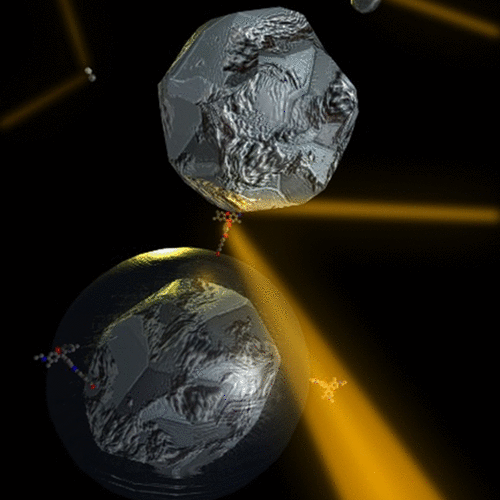当前位置:
X-MOL 学术
›
Chem. Rev.
›
论文详情
Our official English website, www.x-mol.net, welcomes your
feedback! (Note: you will need to create a separate account there.)
Artificial Plasmonic Molecules and Their Interaction with Real Molecules
Chemical Reviews ( IF 51.4 ) Pub Date : 2018-05-21 00:00:00 , DOI: 10.1021/acs.chemrev.7b00647 Gilad Haran 1 , Lev Chuntonov 2
Chemical Reviews ( IF 51.4 ) Pub Date : 2018-05-21 00:00:00 , DOI: 10.1021/acs.chemrev.7b00647 Gilad Haran 1 , Lev Chuntonov 2
Affiliation

|
Plasmonic molecules are small assemblies of nanosized metal particles. Interactions between the particles modify their optical properties and make them attractive for multiple applications in spectroscopy and sensing. In this review, we focus on basic properties rather than on applications. Plasmonic molecules can be created using either nanofabrication methods or self-assembly techniques in solution. The interaction of plasmonic molecules with light leads to excitations that are classified using the concept of normal modes. The simplest plasmonic molecule is a dimer of particles, and its lowest energy excitation takes the form of a symmetric dipolar mode. More complex excitations take place when a larger number of particles is involved. The gaps between particles in a plasmonic molecule form hotspots in which the electromagnetic field is concentrated. Introducing molecules into these hotspots is the basis of a vast spectrum of enhanced spectroscopies, from surface-enhanced Raman scattering to surface-enhanced fluorescence and others. We show in this review how these spectroscopic methods can be used to characterize the fields around plasmonic molecules. Furthermore, the strong fields can be used to drive new phenomena, from plasmon-induced chemical reactions to strong coupling of quantum emitters with the plasmonic fields. We systematically discuss these phenomena, introducing in each case the theoretical basis as well as recent experimental realizations.
中文翻译:

人工等离子分子及其与真实分子的相互作用
等离子体分子是纳米级金属颗粒的小组件。粒子之间的相互作用改变了它们的光学性能,并使其在光谱学和传感领域的多种应用中具有吸引力。在这篇评论中,我们专注于基本属性而不是应用程序。等离子体分子可以使用纳米制造方法或溶液中的自组装技术产生。等离子体分子与光的相互作用导致激发,该激发使用正常模式的概念进行分类。最简单的等离子体分子是粒子的二聚体,其最低能量激发采取对称偶极模式的形式。当涉及更多的粒子时,会发生更复杂的激发。等离子体分子中颗粒之间的间隙形成热点,电磁场集中在这些热点上。将分子引入这些热点是从光谱增强的拉曼散射到表面增强的荧光等各种光谱增强的基础。我们在这篇综述中展示了如何使用这些光谱方法表征等离子体分子周围的场。此外,强场可用于驱动新现象,从等离激元诱导的化学反应到量子发射器与等离激元场的强耦合。我们系统地讨论了这些现象,并分别介绍了理论基础和最新的实验实现。从表面增强的拉曼散射到表面增强的荧光等。我们在这篇综述中展示了如何使用这些光谱方法表征等离子体分子周围的场。此外,强场可用于驱动新现象,从等离激元诱导的化学反应到量子发射器与等离激元场的强耦合。我们系统地讨论了这些现象,并分别介绍了理论基础和最新的实验实现。从表面增强的拉曼散射到表面增强的荧光等。我们在这篇综述中展示了如何使用这些光谱方法表征等离子体分子周围的场。此外,强场可用于驱动新现象,从等离激元诱导的化学反应到量子发射器与等离激元场的强耦合。我们系统地讨论了这些现象,并分别介绍了理论基础和最新的实验实现。从等离激元诱发的化学反应到量子发射体与等离激元场的强耦合。我们系统地讨论了这些现象,并分别介绍了理论基础和最新的实验实现。从等离激元诱发的化学反应到量子发射体与等离激元场的强耦合。我们系统地讨论了这些现象,并分别介绍了理论基础和最新的实验实现。
更新日期:2018-05-21
中文翻译:

人工等离子分子及其与真实分子的相互作用
等离子体分子是纳米级金属颗粒的小组件。粒子之间的相互作用改变了它们的光学性能,并使其在光谱学和传感领域的多种应用中具有吸引力。在这篇评论中,我们专注于基本属性而不是应用程序。等离子体分子可以使用纳米制造方法或溶液中的自组装技术产生。等离子体分子与光的相互作用导致激发,该激发使用正常模式的概念进行分类。最简单的等离子体分子是粒子的二聚体,其最低能量激发采取对称偶极模式的形式。当涉及更多的粒子时,会发生更复杂的激发。等离子体分子中颗粒之间的间隙形成热点,电磁场集中在这些热点上。将分子引入这些热点是从光谱增强的拉曼散射到表面增强的荧光等各种光谱增强的基础。我们在这篇综述中展示了如何使用这些光谱方法表征等离子体分子周围的场。此外,强场可用于驱动新现象,从等离激元诱导的化学反应到量子发射器与等离激元场的强耦合。我们系统地讨论了这些现象,并分别介绍了理论基础和最新的实验实现。从表面增强的拉曼散射到表面增强的荧光等。我们在这篇综述中展示了如何使用这些光谱方法表征等离子体分子周围的场。此外,强场可用于驱动新现象,从等离激元诱导的化学反应到量子发射器与等离激元场的强耦合。我们系统地讨论了这些现象,并分别介绍了理论基础和最新的实验实现。从表面增强的拉曼散射到表面增强的荧光等。我们在这篇综述中展示了如何使用这些光谱方法表征等离子体分子周围的场。此外,强场可用于驱动新现象,从等离激元诱导的化学反应到量子发射器与等离激元场的强耦合。我们系统地讨论了这些现象,并分别介绍了理论基础和最新的实验实现。从等离激元诱发的化学反应到量子发射体与等离激元场的强耦合。我们系统地讨论了这些现象,并分别介绍了理论基础和最新的实验实现。从等离激元诱发的化学反应到量子发射体与等离激元场的强耦合。我们系统地讨论了这些现象,并分别介绍了理论基础和最新的实验实现。











































 京公网安备 11010802027423号
京公网安备 11010802027423号